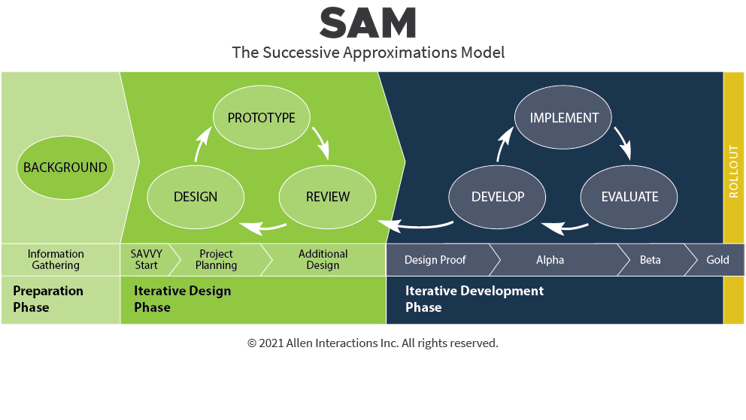Blog
ADDIE vs SAM: A Comparison of Common Characteristics
Shorten training time? Lower training costs? Keep your employees' attention during training? Improve performance outcomes? SAM, an iterative ...

.png?width=1387&height=526&name=2023%20Blog%20Covers%20and%20In-Line%20Graphics%20(40).png)
8 Steps To Shorten Training Time By Up To 60%
By Michael Allen | July 18, 2023 | Custom Learning | 0 Comments
Shorten training time? Lower training costs? Keep your employees' attention during training? Improve performance outcomes? SAM, an iterative instructional design model, starts with performance so your organization can end with performance.
Article originally published on eLearning Industry.
SAM: A High-Powered Instructional Design Model
How have training departments shortened their training time by as much as 60% while doubling their performance? It’s possible, it sure happens, but it takes a departure from the customary presentation of information and a posttest. I’d like to share with you how our studios achieve such spectacular results because you can too. You can significantly shorten training time, lower your training costs, and improve outcome performance. Our studios enjoy a great advantage by using the Successive Approximations Model or SAM. It’s a terrific approach to creating training programs that stand out and are effective. We don’t guard it as a secret, but, in fact, happily share it in hopes it will advance our field as a whole. Your organization will doubtlessly benefit similarly by adopting SAM as has ours.
If you’re a CEO, CFO, HRO, head of ops, or sales, you don’t need to be proficient in the direction or management of SAM. But, you need to know about SAM when you’re investing your money in performance enhancement.
When you invest in training, you must know that it will produce the impact you want. You want to be sure it delivers the level of performance your organization needs to succeed.
You want to be assured the training will:
- Draw and keep the attention of learning employees
- Provide the practice that is essential to reaching a level of proficiency and competency
- Address your KPIs and give you measurable positive returns
In short, you want your money’s worth.
You don’t want a surprise as when a waiter presents you with a meal you didn’t order. No, you want exactly what your organization needs. You want to be sure no employee time is wasted, productivity occurs immediately, and best practices to be on full display.
So, below is a very quick descriptor of The Successive Approximations Model, aka, SAM, at an overview level. These are points of guidance that will be useful for you to know.
SAM: A 3D Rapid Instructional Design Model To Create High-Powered Training
Design
The learning design must not only present best practices clearly but must also consider the learner’s experience. What will keep learners focused, practicing, building skills and confidence, and appreciating the benefits of the training as they see and even witness how their new skills will help them succeed in their work.
Development
Development must verify the effectiveness of the custom eLearning design before it’s too late to improve it. eLearning development must also demonstrate the deliverability of the training via the chosen platforms and quantify delivery practicality before making any greater investment than is needed to demonstrate delivery capabilities at acceptable costs.
Delivery
On-time delivery is always essential. There are always ideas for improvement which, if incorporated, would delay delivery. Is it worth it? A test rollout can provide critical information that often suggests the need for changes previously unidentified. As long as validation time has been reserved in the process, it’s possible to make needed changes without missing the delivery deadline.
SAM: An Iterative 3D Process

SAM iterates and integrates design, development, and delivery work in ways to expect and manage both mistakes and improvement opportunities. It allows for course corrections to be made within budget and timeline. It encourages focus on both content and learning experience.
8 Steps With The SAM Model For Producing Effective Custom Learning
In producing custom learning based on your best practices, The SAM model for agile development prescribes the following steps:
1. First, we learn what you've done in the past if, in fact, you've done any training on the target performance skills. What worked? What didn't? What were the good pieces? What were the weak pieces?
2. The people in your organization, who are responsible for performance such as supervisors, corporate leaders, or project funders, assemble to define success and how it will be measured. These are the people who need to be 100% satisfied with the training produced. They will review alternative training approaches and set the direction.
3. Seasoned high-performance training designers lay out some possibilities and test them with the leadership team and also with some prospective employees who would be trained. We need to see how they react before we spend too much time and money and lose the opportunity to make corrections.
4. With SAM, we don’t just go with our first idea, even if it seems like it’s working. We set the first aside and challenge ourselves to do something that would work even better. And then we test that one as we did with our first ideas.
5. Three times is a charm! We go one more time. We set aside those first two ideas and go a third time. What would be even better, even more effective, even more engaging, and even more fun for learners? We want to hit that target right in the center.
6. At this point, we can be assured we’re on top of something that’s going to be amazing. But to double our confidence, we produce something called a “Design Proof” that everyone can review and comfortably say, “I want this.”
7. At this point, we can determine what it’s going to cost, how long it’s going to take to develop, and if we need to make compromises to fit constraints.
8. And finally, we make it happen.
I can confidently say, training dollars will never go further nor return a greater impact than SAM delivers.

About the Author: Michael Allen
Go to https://www.alleninteractions.com/bio/dr-michael-allen Michael W. Allen, PhD, has been a pioneer in the e-learning industry since 1970. For decades, Allen has concentrated on defining unique methods of instructional design and development that provide meaningful, memorable, and motivational learning experiences through enhanced cognitive interactivity. He developed the advanced design and development approaches we have used at Allen Interactions for the past three decades, including CCAF-based design and the SAM process for iterative, collaborative development. Michael is a prolific writer, sought-after conference speaker, and recognized industry leader, having written or edited nine books on designing effective e-learning solutions, including his latest edition: Michael Allen’s Guide to e-Learning. He has contributed chapters to textbooks and handbooks published by leading authors and associations.
Comments
Would you like to leave a comment?
Related Blog Posts
.png?width=316&name=2023%20Blog%20Covers%20and%20In-Line%20Graphics%20(65).png)
By: Michael Allen | Jan, 2022
Category: Custom Learning, Dr. Michael Allen
.png?width=316&name=2023%20Blog%20Covers%20and%20In-Line%20Graphics%20(8).png)
Blog
3 Essential Concepts to Evolve e-Learning Experiences
Shorten training time? Lower training costs? Keep your employees' attention during training? Improve performance outcomes? SAM, an iterative ...
By: Michael Allen | Jan, 2023
Category: Custom Learning
.png?width=316&name=2023%20Blog%20Covers%20and%20In-Line%20Graphics%20(49).png)
Blog
Deeper Learning™: How to Actually Get the Results You Care About
Shorten training time? Lower training costs? Keep your employees' attention during training? Improve performance outcomes? SAM, an iterative ...
By: Michael Allen | May, 2023
Category: Custom Learning, Dr. Michael Allen


